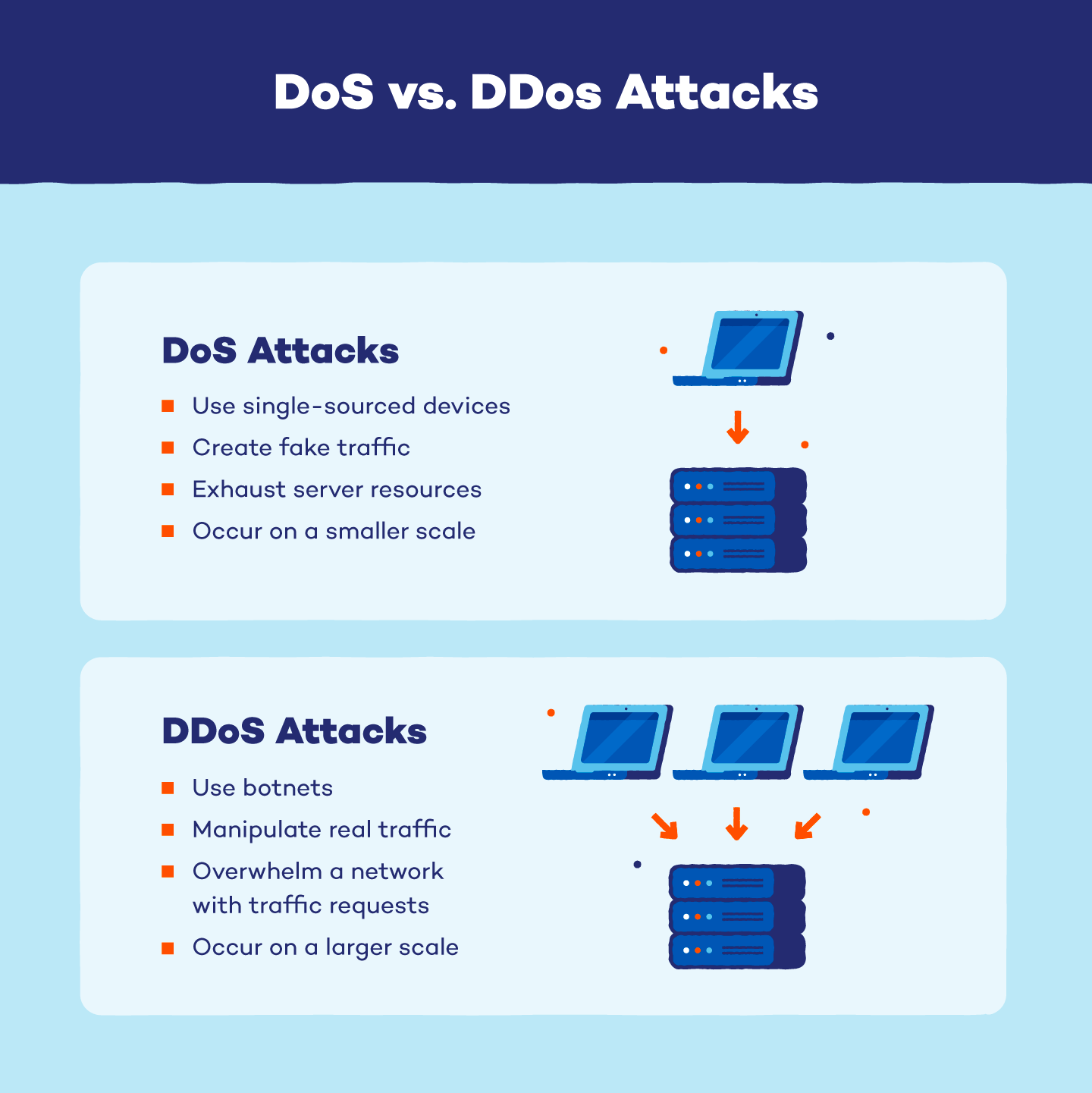Plenty of popular brands — like Google, WhatsApp and Meta — have been attacked and impaired by cybercriminals. With acronyms like SQL, MITM or even DDoS, it can be difficult to figure out just how a cyberattack could affect you or an organization. It’s possible you’ve even found yourself searching “DDoS meaning” on a search engine.
While more than 30 million users trust Panda Security to provide them with premium services, support and protection from online attacks, major companies are still constantly under threat. Continue reading to learn how you or your organization might recognize a DDoS attack and prevent one in the future.
What Is DDoS?
DDoS stands for distributed denial of service and is often used to reference a type of network attack known as a DDoS attack. DDoS attacks are a subclass of regular denial-of-service (DoS) attacks.
Unlike more common cyberattacks, hackers will use DDoS attacks to shut down a website or network system instead of penetrating a security perimeter. Additionally, DDoS attacks can be used as distractions during larger-scale cyberattacks.
Successful DDoS attacks can impact online networks for days, weeks and even months, and are frequently used for political, religious, social, military or personal gain. If an online network is attacked through service denial, every aspect of its organization can be impacted, including its finances, branding and customer base.
What Is a Botnet?
Botnets are a collection of seized devices — including mobile phones, computers, Internet of Things devices and more — that DDoS attackers use to distribute malware across servers. This malware, commonly referred to as a bot, then turns servers and attacked devices into “zombies” within the botnet itself. These attacked devices then become part of a zombie network that is remotely controlled by the attacker.
With the variety of devices in a botnet, attackers are able to conceal where their malicious traffic originates. This makes detecting and shutting down DDoS attacks more difficult. Plus, multiple devices make it easier for an attacker to overwhelm a victim’s servers with too many requests.
DoS vs. DDoS

While it may seem like DoS and DDoS are nearly identical, there are actually a variety of differences between these types of cyberattacks. In DDoS attacks, a hacker will use many different network devices to distribute an attack across a system. These types of attacks manipulate legitimate traffic instead of creating fake traffic.
On the other hand, a DoS attack doesn’t use multiple devices. In fact, DoS attacks don’t even target multiple internet access points. These attacks will use vulnerabilities and fake traffic requests to overwhelm a system, effectively causing a single-source attack.
Because a DDoS attack uses real traffic, the malware it distributes and its movements are more obscured than in a regular DoS attack. While both can effectively take systems offline, DDoS attacks are usually larger in scale and more difficult to identify and fight off.
What Is a DDoS Attack?
A DDoS attack is a cyberattack used to make an online network, resource or other cyber host unavailable to its requesters on the internet. For example, some of the greatest DDoS attacks in history have targeted and successfully taken major organizations like Amazon Web Services and Google offline. These types of attacks can be particularly dangerous because they’re often controlled remotely.
Many of these distributed denial-of-service attacks are also difficult to prevent, identify and mitigate. DDoS attackers avoid detection in a number of ways, particularly by:
- Spoofing: Spoofing — including DNS spoofing — is when an attacker will replicate source addresses and send legitimate traffic to illegitimate sites or destinations.
- Reflecting: Reflecting refers to when an attacker changes the normal behavior of internet services to hide their malicious actions.
- Amplifying: Amplifying is when an attacker uses a source modifier to create large amounts of traffic that can then overwhelm a network or server.
Not all DDoS attacks will use these protection mechanisms, but they are the most common ways a hacker will attempt to avoid detection. These techniques can make it extremely difficult to identify a DDoS attack as it is happening. Many of the symptoms of a DDoS attack can be caused by regular spikes in traffic. However, there are a few things to be aware of that could signify a DDoS attack is occurring:
- Slow upload or download speeds
- Unavailable websites
- Lost internet connections
- Pop-up ads or unusual media
- Excessive spam
- Traffic originating from a single IP address
- A surge in requests to a single page
- Spikes of traffic at odd hours of the day
Each type of attack has more specific signs, but these common DDoS attack symptoms could alert you to an attack before it’s in full force.

Types of DDoS Attacks
According to the open systems interconnection (OSI) model, a network has seven different connection layers that help networks communicate with each other. Because these layers individually determine the behaviors, tools and techniques needed to invade it, each type of DDoS attack is classified based on the layers it targets and the behaviors it needs to replicate.
The three types of DDoS attacks are:
- Application layer attacks
- Protocol or network layer attacks
- Volumetric attacks
Each of these types of DDoS attacks can be broken down further based on the duration of the attack:
- Long-term attacks: A long-term DDoS attack is any attack that lasts hours, days, weeks, months or longer.
- Burst attacks: A burst DDoS attack will usually only last a few seconds to a few minutes.
No matter how long an attack lasts, the damage can be crippling to each targeted connection layer.
Application Layer Attacks
Application layer attacks are also referred to as seven-layer attacks because they target the seventh layer of the OSI model. This layer generates webpages in response to HTTP requests, so DDoS attacks will attempt to overwhelm a network’s traffic requests. These HTTP flood attacks can be simple or complex while targeting one or multiple IP addresses at once.
Protocol or Network Layer Attacks
Protocol attacks, also called network layer attacks, usually target levels three and four of a network’s communication system. These attacks overwhelm the capacity of the resources in these layers, like firewalls, which causes a state of exhaustion to overtake the system. SYN floods and smurf attacks are examples of protocol attacks that target the third or fourth OSI layers.
Volumetric Attacks
Volumetric attacks attempt to overwhelm a network and its connection to the internet. Attackers will amplify data and other communication requests to the extent where a system is unable to operate successfully. DNS attacks, including DNS amplification attacks, are commonly used to increase the volume of traffic for volumetric attacks.
Motives for DDoSing
DDoSing — the term used when someone executes a DDoS attack — can result from a variety of motives. While these motives are different for every hacker, they can range anywhere from political gain to social justice.
- Hacktivism: Hacktivism is a form of digital activism. Hacktivists usually engage in hacktivism to reach social, political or religious justice, and they often fight for the greater good. Some hackers will use DDoS attacks during a hacktivism campaign.
- Cybervandalism: Cybervandalism is a cyberattack often without social, political, religious or criminal intentions. Most online vandalism acts are intended to show a hacker’s expertise, and vandals often pay a DDoS-for-hire to initiate DDoS booters and IP stressors.
- Cyberwarfare: Unlike cybervandalism, cyberwarfare has political or military intent and is often used to overtake or dismember organizational infrastructures. Many of these types of DDoS attacks are state-sanctioned and can disrupt finances, healthcare and government security.
- Extortion: A cybercriminal may demand money or other resources while threatening a DDoS attack. If the victim complies, the attacker may not issue the attack. On the other hand, if the victim does not comply, organizations may be forced to go offline until the threat has passed or been mitigated.
- Rivalries: DDoS attacks are sometimes used as competition tools for both personal and professional rivalries. These attacks can dissuade people from going to events, shut down online storefronts, cause reputational damage and more.

Preventing a DDoS Attack
While there is no one-stop shop for DDoS protection, there are a few ways you can prepare your systems for a potential attack. Being aware of the possibility of a DDoS attack is the first step, and these five tips are the next best ways to prevent a possible system attack.
1. Vulnerability Assessments
If you run an organization with an information and security infrastructure system, it’s important to perform regular vulnerability assessments. In addition to simply finding system vulnerabilities, a vulnerability assessment can also document these findings and provide guidance for threat solutions. Penetration tests are also recommended, and white hat hackers can be hired to help run these tests and find and alert you to possible weaknesses or entry points.
2. Black Hole Routing
Black hole routing is a more extreme prevention and protection tactic. If you have reason to assume that you may fall victim to a DDoS attack, a black hole route can send all of your traffic on a neutral route away from your systems. This will remove all legitimate traffic — both good and bad — which can lead to business loss.
3. Rate Limiting
Rate limiting is one way to prevent or mitigate a DDoS attack. This lowers the number of requests a server can accept based on a specific timeframe, which can stop a DDoS attack from damaging or overtaking your systems. While this prevention tactic may not work for all attacks, it can reduce the damage one may cause.
4. Network Diffusion
Instead of allowing a DDoS attack to overwhelm and take over a network, network diffusion disperses traffic between a variety of distributed servers so it is absorbed by the network itself. This spreads the distributed denial-of-service attack’s impact so it becomes manageable instead of destructive.
5. Firewalls
In the event of a seven-layer DDoS attack, it’s important to have a web application firewall in effect. This is a tool that separates the server from the internet and offers an additional layer of security protection from dangerous and overwhelming traffic. Additionally, firewalls can implement custom rules during an attack to better disperse or accept traffic.
While those carrying out a DDoS attack can be sneaky, there are ways to protect your business, your home and yourself. By investing in security protocols, including VPNs and protection plans, you can be prepared for a DDoS attack at any time.







